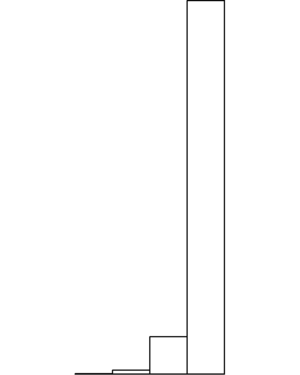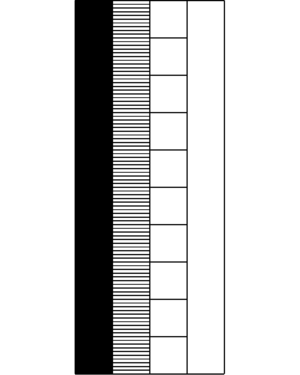Ornstein–Uhlenbeck process: Difference between revisions
→Scaling limit interpretation: small addition for clarity |
|||
| Line 1: | Line 1: | ||
[[File:Three_decades.png|thumb|Three decades: 0.01, 0.1, 1, 10 (10<sup>-2</sup>, 10<sup>-1</sup>, 10<sup>0</sup>, 10<sup>1</sup>).]] | |||
[[File:Three_decades_x10.png|thumb|Three decades: One-thousand 0.01's, one-hundred 0.1's, ten 1's, one 10.]] | |||
One '''decade''' is a [[factorization|factor]] of 10 difference between two numbers (an [[order of magnitude]] difference) measured on a [[logarithmic scale]]. Along with the [[octave (electronics)|octave]], it is a [[units of measurement|unit]] used to describe [[frequency|frequency bands]] or [[interval ratio|frequency ratios]].<ref name="Levine">Levine, William S. (2010). ''The Control Handbook: Control System Fundamentals'', p.9-29. ISBN 9781420073621.</ref><ref name="Perdikaris">Perdikaris, G. (1991). ''Computer Controlled Systems: Theory and Applications'', p.117. ISBN 9780792314226.</ref> It is especially useful when referring to frequencies and when describing [[frequency response]] of [[electronics|electronic systems]], such as [[audio amplifier]]s and [[electronic filter|filters]]. | |||
==Calculations== | |||
The factor-of-ten in a decade can be in either direction: so one decade up from 100 Hz is 1000 Hz, and one decade down is 10 Hz. The factor-of-ten is what is important, not the unit used, so 3.14 rad/s is one decade down from 31.4 rad/s. | |||
To determine the number of decades between two frequencies (<math>f_1</math> & <math>f_2</math>), use the [[logarithm]] of the ratio of the two values: | |||
*<math>\log_{10} (f_2/f_1)</math> decades<ref name="Levine"/><ref name="Perdikaris"/> | |||
or, using [[natural logarithm]]s: | |||
*<math>\ln f_2 - \ln f_1\over\ln 10</math> decades<ref>Davis, Don and Patronis, Eugene (2012). ''Sound System Engineering'', p.13. ISBN 9780240808307.</ref> | |||
:How many decades is it from 15 rad/s to 150,000 rad/s? | |||
::<math>\log_{10} (150000/15) = 4</math> decades | |||
:How many decades is it from 3.2 GHz to 4.7 MHz? | |||
::<math>\log_{10} (4.7\times10^6 / 3.2\times10^9 ) = -2.83</math> decades | |||
:How many decades is one octave? | |||
::One octave is a factor of 2, so <math>\log_{10} (2) = 0.301</math> decades per octave (decade = [[just major third]] + three octaves, 10/1 = 5/4) | |||
To find out what frequency is a certain number of decades from the original frequency, multiply by appropriate powers of 10: | |||
:What is 3 decades down from 220 Hz? | |||
::<math>220 \times 10^{-3} = 0.22</math> Hz | |||
:What is 1.5 decades up from 10? | |||
::<math>10 \times 10^{1.5} = 316.23</math> | |||
To find out the size of a step for a certain number of frequencies per decade, raise 10 to the power of the inverse of the number of steps: | |||
:What is the step size for 30 steps per decade? | |||
::<math> 10^{1/30} = 1.079775</math> - or each step is 7.9775% larger than the last. | |||
[[Image:Butterworth filter bode plot.png|350px|thumb|right|[[Bode plot]] showing the concept of a decade: each major division on the horizontal axis is one decade]] | |||
==Graphical representation and analysis== | |||
Decades on a logarithmic scale, rather than unit steps (steps of 1) or other [[linear]] scale, are commonly used on the horizontal axis when representing the frequency response of electronic circuits in graphical form, such as in [[Bode plot]]s, since depicting large frequency ranges on a linear scale is often not practical. For example, an [[audio amplifier]] will usually have a frequency band ranging from 20 Hz to 20 kHz and representing the entire band using a decade log scale is very convenient. Typically the graph for such a representation would begin at 1 Hz (10<sup>0</sup>) and go up to perhaps 100 kHz (10<sup>5</sup>), to comfortably include the full audio band in a standard-sized [[graph paper]], as shown below. Whereas in the same distance on a linear scale, with 10 as the major step-size, you might only get from 0 to 50. | |||
[[Image:Decade vs Linear.svg|400px|1,10,100,1k,10k,100k using decades vs. 0,10,20,30,40,50 using linear scale]] | |||
Electronic frequency responses are often described in terms of "per decade". The example Bode plot shows a slope of -20 [[Decibel|dB]]/decade in the stopband, which means that for every factor-of-ten increase in frequency (going from 10 rad/s to 100 rad/s in the figure), the gain decreases by 20 dB. | |||
==See also== | |||
* [[Savart]] | |||
==Sources== | |||
{{reflist}} | |||
{{DEFAULTSORT:Decade (Log Scale)}} | |||
[[Category:Charts]] | |||
[[Category:Logarithmic scales of measurement]] | |||
Revision as of 23:14, 28 December 2013


One decade is a factor of 10 difference between two numbers (an order of magnitude difference) measured on a logarithmic scale. Along with the octave, it is a unit used to describe frequency bands or frequency ratios.[1][2] It is especially useful when referring to frequencies and when describing frequency response of electronic systems, such as audio amplifiers and filters.
Calculations
The factor-of-ten in a decade can be in either direction: so one decade up from 100 Hz is 1000 Hz, and one decade down is 10 Hz. The factor-of-ten is what is important, not the unit used, so 3.14 rad/s is one decade down from 31.4 rad/s.
To determine the number of decades between two frequencies ( & ), use the logarithm of the ratio of the two values:
or, using natural logarithms:
- decades[3]
- How many decades is it from 15 rad/s to 150,000 rad/s?
- How many decades is it from 3.2 GHz to 4.7 MHz?
- How many decades is one octave?
- One octave is a factor of 2, so decades per octave (decade = just major third + three octaves, 10/1 = 5/4)
To find out what frequency is a certain number of decades from the original frequency, multiply by appropriate powers of 10:
To find out the size of a step for a certain number of frequencies per decade, raise 10 to the power of the inverse of the number of steps:

Graphical representation and analysis
Decades on a logarithmic scale, rather than unit steps (steps of 1) or other linear scale, are commonly used on the horizontal axis when representing the frequency response of electronic circuits in graphical form, such as in Bode plots, since depicting large frequency ranges on a linear scale is often not practical. For example, an audio amplifier will usually have a frequency band ranging from 20 Hz to 20 kHz and representing the entire band using a decade log scale is very convenient. Typically the graph for such a representation would begin at 1 Hz (100) and go up to perhaps 100 kHz (105), to comfortably include the full audio band in a standard-sized graph paper, as shown below. Whereas in the same distance on a linear scale, with 10 as the major step-size, you might only get from 0 to 50.
1,10,100,1k,10k,100k using decades vs. 0,10,20,30,40,50 using linear scale
Electronic frequency responses are often described in terms of "per decade". The example Bode plot shows a slope of -20 dB/decade in the stopband, which means that for every factor-of-ten increase in frequency (going from 10 rad/s to 100 rad/s in the figure), the gain decreases by 20 dB.
See also
Sources
43 year old Petroleum Engineer Harry from Deep River, usually spends time with hobbies and interests like renting movies, property developers in singapore new condominium and vehicle racing. Constantly enjoys going to destinations like Camino Real de Tierra Adentro.
- ↑ 1.0 1.1 Levine, William S. (2010). The Control Handbook: Control System Fundamentals, p.9-29. ISBN 9781420073621.
- ↑ 2.0 2.1 Perdikaris, G. (1991). Computer Controlled Systems: Theory and Applications, p.117. ISBN 9780792314226.
- ↑ Davis, Don and Patronis, Eugene (2012). Sound System Engineering, p.13. ISBN 9780240808307.









